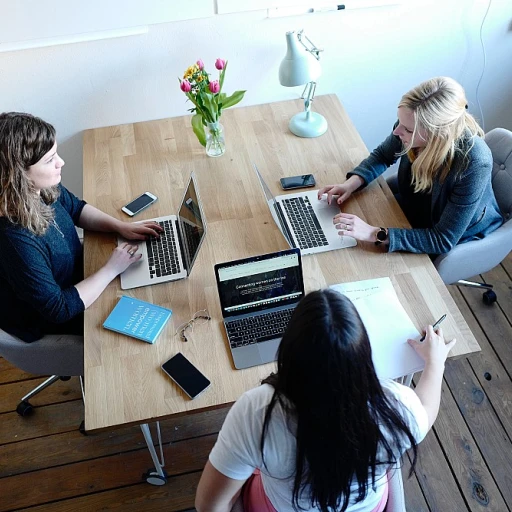Understanding the Modern Talent Landscape
Recognizing the Shift in Talent Dynamics
The modern talent landscape is evolving at an unprecedented pace, driven by technological advancements and changing workforce expectations. Companies are increasingly focusing on creative approaches to nurturing talent, recognizing that traditional methods may no longer suffice. This shift is not just about finding individuals with the right skills but also about fostering an environment where innovation thrives.
Organizations are now looking beyond conventional recruitment and development strategies to exciting HR gatherings and events that offer fresh perspectives on talent management. These gatherings often serve as platforms for sharing talent ideas and team-building exercises that can be easily adapted to various workplace settings.
Embracing Diverse Talent Pools
In today's competitive landscape, embracing diversity is no longer just a moral imperative but a strategic advantage. Diverse teams bring a wealth of ideas and perspectives that can drive innovation and creativity. By tapping into a wide array of talents, from music and dance to spoken word and stand-up comedy, organizations can create a vibrant and inclusive culture that attracts top talent.
Moreover, fostering a family-like atmosphere where employees feel valued and included can lead to higher engagement and retention. This approach encourages team members to bring their whole selves to work, unleashing their full potential and contributing to a dynamic and fun office environment.
Adapting to Changing Workforce Needs
As the workforce becomes more diverse and multifaceted, organizations must adapt their talent strategies to meet the unique needs of their employees. This includes offering flexible work arrangements, personalized development opportunities, and a focus on work-life balance. By understanding the needs and aspirations of their team, companies can create a supportive environment that nurtures growth and innovation.
Ultimately, the key to thriving in the modern talent landscape lies in the ability to anticipate and respond to these changes with agility and creativity. By leveraging technology and fostering a culture of continuous learning, organizations can stay ahead of the curve and ensure their teams are equipped with the skills needed to succeed in an ever-changing world.
Leveraging Technology for Talent Development
Utilizing Technology to Boost Talent
In today's fast-paced work environment, leveraging technology is crucial for developing talent within an organization. The integration of advanced tools allows teams to harness their skills effectively while ensuring that the learning process remains fun and engaging for all participants. By implementing effective technological solutions, companies ensure that their talent development initiatives reach a wider audience within a shorter timeframe.- Collaboration Platforms: Utilizing tools that foster communication can create a dynamic atmosphere where ideas flow freely. With the right collaboration platform, it becomes easier for teams to share talent ideas and collaborate on team-building exercises, like school talent shows or even office dance routines.
- Online Learning Portals: Tailoring content to cater to individual interests keeps participants motivated. Platforms that offer a variety of learning modules can transform how your team approaches talent development. These portals span a multitude of subjects, from magic tricks and spoken word to easy talents like lip sync or minute talent routines.
- Virtual Reality & Augmented Reality: These technologies offer immersive experiences that can enhance traditional skill development. Imagine a virtual school where you can refine your dance routine, or even a virtual company retreat where you participate in a talent work session with your family or colleagues.
Cultivating a Culture of Continuous Learning
Embracing a Spirit of Lifelong Learning
In a rapidly evolving job market, talent development is no longer an option but a necessity. Companies must prioritize a culture that encourages continuous learning and development, fostering environments where team members are eager to enhance their skills. The journey of talent nurturing involves creating opportunities for dynamic learning experiences and encouraging participation across all levels. One effective approach is to integrate tailored learning programs that cater to the diverse skill sets and interests of the team. Consider setting up sessions where employees can share their expertise, learn from peers, and harness new ideas in a supportive atmosphere. This can be achieved through creative outlets such as:- Team Building Activities: These are great for sparking collaboration and creativity. Participants can engage in fun talent challenges like dance routines or stand-up comedy, providing a platform to showcase unconventional talents, ultimately boosting morale and team cohesion.
- Skill Workshops: Hosting minute talent sessions where employees can present easy-to-learn skills that might not be essential to their role but fuel personal satisfaction and career growth. These skill-sharing events could range from discussing magic tricks to sharing a favorite fun talent from their school talent days.
Personalized Employee Experiences
Crafting Unique Employee Journeys
In today's dynamic work environment, creating personalized employee experiences is not just a trend; it's a necessity. Companies are recognizing that to nurture talent effectively, they must tailor experiences to meet individual needs and aspirations. This approach not only enhances job satisfaction but also boosts engagement and retention.
One innovative way to personalize the employee journey is by incorporating talent showcases into the workplace. Imagine a talent extravaganza where employees can display their unique skills, be it through dance routines, magic tricks, or even a stand-up comedy session. Such events can be organized as part of a company retreat or a regular office gathering, providing a platform for team members to shine outside their usual roles.
Moreover, integrating fun talent ideas into team-building activities can foster a sense of community and belonging. Encouraging employees to participate in lip sync battles or spoken word performances can break the monotony of daily tasks and inject a sense of fun and creativity into the workplace. These activities not only highlight the diverse talents within a team but also help in building stronger interpersonal connections.
To ensure these initiatives are effective, it's crucial to gather feedback from participants and tailor future events to better suit the audience. This might involve setting up a family talent show where employees can bring their loved ones, creating a more inclusive and engaging environment. Additionally, offering workshops on easy-to-learn talents like minute magic tricks or funny talent ideas can encourage employees to step out of their comfort zones and explore new skills.
Ultimately, by crafting personalized experiences, organizations can create a workplace culture that values individuality and encourages employees to bring their whole selves to work. This not only enhances the overall employee experience but also drives innovation and creativity within the team.
Diversity and Inclusion as Innovation Drivers
Embracing Diversity and Inclusion for Innovative Growth
In the ever-evolving landscape of human resources, embracing diversity and inclusion has become a cornerstone for fostering innovation. By integrating diverse perspectives, organizations can create a vibrant talent pool that drives creativity and problem-solving. This approach not only nurtures unique skills but also sets the stage for a more dynamic and inclusive workplace.
Diversity in the workplace is more than just a buzzword; it is a critical component of a successful team. A diverse team brings together a wide range of talents, ideas, and experiences, which can lead to innovative solutions and a more engaging work environment. By valuing different backgrounds and perspectives, companies can tap into a broader range of talent ideas and create a culture where everyone feels valued and heard.
To truly leverage the power of diversity, organizations must go beyond mere representation. They need to cultivate an inclusive culture where all team members feel empowered to share their ideas. This can be achieved through initiatives such as diversity training, inclusive hiring practices, and creating safe spaces for open dialogue. By doing so, companies can ensure that their diversity efforts translate into meaningful innovation and growth.
Furthermore, diversity and inclusion can be a source of fun and creativity within the office. Activities like talent shows or team-building events can showcase the unique skills and talents of employees, from music and dance routines to stand-up comedy and spoken word performances. These events not only highlight the diverse talents within the team but also foster a sense of community and belonging.
In conclusion, by embracing diversity and inclusion, organizations can unlock the full potential of their workforce. This approach not only enhances team dynamics but also drives innovation and growth, making it an essential component of any modern HR strategy.
Measuring the Impact of Innovative HR Practices
Evaluating the Success of Cutting-edge HR Initiatives
In an ever-evolving landscape where talent is key and development strategies shift, assessing the success of innovative HR practices is vital. It ensures that organizations can create impactful experiences for their teams while maximizing resources.
One key metric for determining the effectiveness of these initiatives is employee engagement. Engaged employees show a higher level of commitment and contribute positively to the team dynamics. It's about measuring the activities that foster creativity and innovation within the team, whether it's a weekly idea-sharing session or a company retreat filled with team-building activities like a talent show featuring dance routines, magic tricks, or stand-up comedy.
- Talent Extravaganza Participation: Tracking the participants and audience engagement in these events can give a good indicator of how well employees feel connected and valued.
- Skills Development Impact: Assess whether the skills honed during workshops or seminars—like music or spoken word sessions—translate to enhanced job performance. Identifying if these skills will indeed benefit the business.
- Idea Generation: Encourage a culture where employees regularly submit new ideas, observing not just the quantity but the quality and feasibility of such talent ideas.
- Team Cohesion: Evaluating how easy talent activities and fun group endeavors impact trust within teams offers a perspective on collaboration improvements post-initiatives.
- Diversity Metrics: Ensuring a range of backgrounds and perspectives are featured in events can demonstrate diversity as a driver of innovation.
Finally, conducting regular surveys can assess how employees perceive these initiatives. The feedback gleaned from such surveys can be invaluable in refining future activities, ensuring the learning experiences remain relevant, engaging, and fun. Measuring this impact in an organized, deliberate manner strengthens the overall strategic approach in nurturing talent in the office. It's a testament to the power of an idea that when carefully executed, it enhances the work atmosphere and drives growth across the organization.



